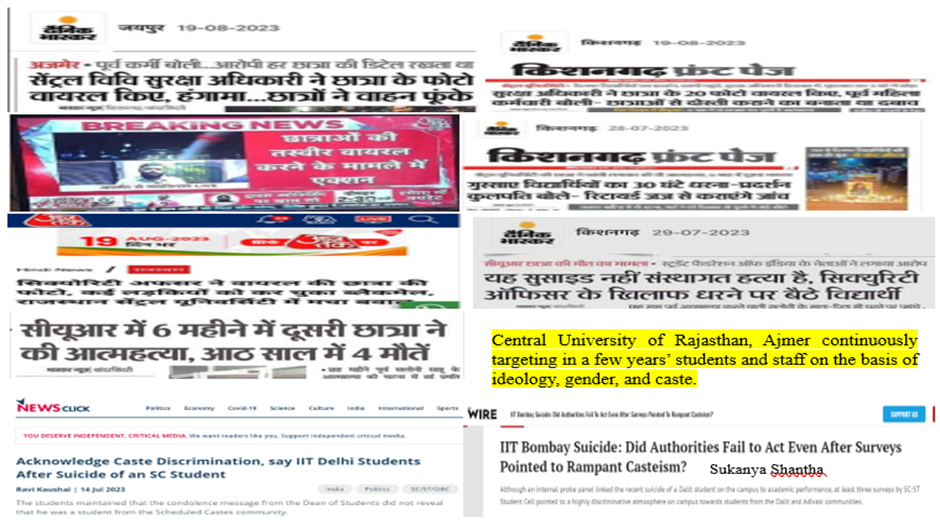Deepika Kumari Meena
While India strives to be known as a “VishwaGuru” or a worldwide leader in the modern era, accepting pervasive prejudice inside our educational institutions is depressing. This raises the dilemma of how we can become “VishwaGurus” while dealing with inequality in the educational system. A university is considered a place where students should feel comfortable where they can express their opinions freely without fear, but this doesn’t happen on all campuses around the country. In Indian universities, discrimination still exists in the field of higher education. It is ingrained in the very nature of these institutions and operates along ideological, gendered, and caste-based fault lines. Despite significant socioeconomic advances, these prejudices persist in society, sustaining inequities and impeding the development of an inclusive learning environment. Ideological discrimination frequently stifles opposing views, restricts academic freedom, and promotes a culture where following the crowd is valued above exercising critical thinking. The fundamental idea of a university as a place for unfettered thinking and exploration is undermined when students and faculty members share opinions that contradict the dominant narrative without fear of rejection, reprimand, or even expulsion.
Even though there are laws against it, caste-based discrimination still exists at Indian colleges and universities. Based on their caste identification, Dalit and disadvantaged students and professors frequently encounter marginalization, unfair treatment, and prejudice. This maintains a hostile environment that hinders their academic development and adds to their underrepresentation in various disciplines. Within the academic space, often professors and students are not free to express their opinions freely, and girls on campus are subject to gender discrimination from the administration. The situation at Ashoka University, where a professor’s suspension was purportedly connected to their research endeavors, is stark evidence of such prejudice. In the academic community, it’s a hot topic of discussion because the voices of countries’ top institutions are being heard by all the leading news channels and other academics. Students in central universities are also discriminated against daily by the administration based on their caste and gender identity. Are their voices being heard by top institutions and higher educational institutions?
 Sources: Danik Bhaskar, AAJ Tak, Wire by Sukanya, NEWS Click by Ravi Kaushal
Sources: Danik Bhaskar, AAJ Tak, Wire by Sukanya, NEWS Click by Ravi Kaushal
Similarly, discrimination against faculty and students occurred at the Central University of Rajasthan (CURAJ). But because CURAJ is not included among prestigious universities like Ashoka University, JNU, HCU, and AMU, which frequently grab attention when concerns concerning prejudice occur, its situation still needs to be discovered in the larger conversation. It is troubling that incidents of prejudice occurring in less well-known universities like CURAJ continue to go unreported, highlighting the unfair focus on these concerns that are only present in more prominent educational institutions. Regardless of the prestige of educational institutions, it is crucial to recognise and correct such types of prejudice to promote a more fair and inclusive society.
Even if certain high-profile cases get media attention, the bulk of discriminating incidents go unreported since there aren’t any reporting procedures in place, and society is more accepting of such biases. Universities must take aggressive initiatives to address this pervasive issue. Some of these are providing safe places for marginalized groups, awareness campaigns, sensitization seminars, and strict anti-discrimination regulations.
At the Central University of Rajasthan, a Master’s student is being harassed by the university’s security officer. A security officer makes viral a girl student’s photos because he thought her dress wasn’t appropriate and had all the right to do that. This isn’t the first time the university’s security officer has been the subject of complaints. According to internal sources, female staff members also complain about him, but the university administration never takes proper action against him. It’s not the first time that university administrations target girl students. In six months, two girl students committed suicide on campus, but the administration conducted no proper investigation. There is no clear explanation yet for why these students committed suicide.
Although students come to the university to learn and use all its facilities, female students can only use some facilities as male students do, even after paying the exact fees and staying on campus. Due to different timings, girls can’t use library services equally as their male counterparts. In the beginning, girls were not allowed to use the library after 8 PM when I attended the CURAJ campus, but after repeated protests, girl students were allowed to use the library until 10 PM, and for the boys, it was 12 PM. It doesn’t end here; after 10 pm, the girls’ hostels are locked from the inside, whereas on the same campus, boys are allowed outside their hostel anytime and can even go outside the campus. Women at all stages of higher education are impacted by gender discrimination, a pervasive problem. Their academic and professional success is hampered by unequal access to opportunities, stereotypes, and harassment. The lack of women in leadership positions in professions emphasizes the severity of this problem and highlights the need for comprehensive legislative and cultural changes to ensure fair treatment.
The students intend to hold a protest to demand that the administration treats them equally and stops discriminating against them based on their gender identity and that a safe environment is created so that students can concentrate on their studies. When students protest, only the administration listens and comes for a discussion, but they don’t take any proper action to solve students’ problems. The administration repeatedly fails to create a safe place for the girls’ students on campus because the girls seem unsafe. What is the reason for this behaviour on the residential campus, and who is responsible here?
Families are sending their daughters to higher educational institutions away from home so their daughters can get a better education, make themselves independent, and trust the university administration. Still, are the girls safe in the university space? By encouraging free discussion, welcoming a variety of opinions, and maintaining the ideals of equality and justice, higher education should act as a catalyst for societal change. Indian colleges can set the path for a more inclusive and progressive future by challenging prejudice based on ideology, gender, and caste.
~~~
Deepika Meena is a research Scholar at IIT Gandhinagar. Her research interests are tribal development, gender studies, education and public policy.








